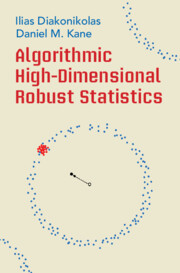Refine search
Actions for selected content:
1004 results in Computational statistics, machine learning and information science
1 - Introduction to Robust Statistics
-
- Book:
- Algorithmic High-Dimensional Robust Statistics
- Published online:
- 24 August 2023
- Print publication:
- 07 September 2023, pp 1-28
-
- Chapter
- Export citation
3 - Algorithmic Refinements in Robust Mean Estimation
-
- Book:
- Algorithmic High-Dimensional Robust Statistics
- Published online:
- 24 August 2023
- Print publication:
- 07 September 2023, pp 61-99
-
- Chapter
- Export citation
5 - List-Decodable Learning
-
- Book:
- Algorithmic High-Dimensional Robust Statistics
- Published online:
- 24 August 2023
- Print publication:
- 07 September 2023, pp 119-165
-
- Chapter
- Export citation
Appendix - Mathematical Background
-
- Book:
- Algorithmic High-Dimensional Robust Statistics
- Published online:
- 24 August 2023
- Print publication:
- 07 September 2023, pp 265-270
-
- Chapter
- Export citation
Contents
-
- Book:
- Algorithmic High-Dimensional Robust Statistics
- Published online:
- 24 August 2023
- Print publication:
- 07 September 2023, pp vii-x
-
- Chapter
- Export citation
Dedication
-
- Book:
- Algorithmic High-Dimensional Robust Statistics
- Published online:
- 24 August 2023
- Print publication:
- 07 September 2023, pp v-vi
-
- Chapter
- Export citation
References
-
- Book:
- Algorithmic High-Dimensional Robust Statistics
- Published online:
- 24 August 2023
- Print publication:
- 07 September 2023, pp 271-281
-
- Chapter
- Export citation
8 - Information-Computation Trade-offs in High-Dimensional Robust Statistics
-
- Book:
- Algorithmic High-Dimensional Robust Statistics
- Published online:
- 24 August 2023
- Print publication:
- 07 September 2023, pp 229-264
-
- Chapter
- Export citation
Index
-
- Book:
- Algorithmic High-Dimensional Robust Statistics
- Published online:
- 24 August 2023
- Print publication:
- 07 September 2023, pp 282-284
-
- Chapter
- Export citation
4 - Robust Covariance Estimation
-
- Book:
- Algorithmic High-Dimensional Robust Statistics
- Published online:
- 24 August 2023
- Print publication:
- 07 September 2023, pp 100-118
-
- Chapter
- Export citation
Frontmatter
-
- Book:
- Algorithmic High-Dimensional Robust Statistics
- Published online:
- 24 August 2023
- Print publication:
- 07 September 2023, pp i-iv
-
- Chapter
- Export citation

Algorithmic High-Dimensional Robust Statistics
-
- Published online:
- 24 August 2023
- Print publication:
- 07 September 2023
12 - Optimal Particle Filter
-
- Book:
- Inverse Problems and Data Assimilation
- Published online:
- 27 July 2023
- Print publication:
- 10 August 2023, pp 153-163
-
- Chapter
- Export citation
8 - The Kalman Filter and Smoother
-
- Book:
- Inverse Problems and Data Assimilation
- Published online:
- 27 July 2023
- Print publication:
- 10 August 2023, pp 112-124
-
- Chapter
- Export citation
Part II - Data Assimilation
-
- Book:
- Inverse Problems and Data Assimilation
- Published online:
- 27 July 2023
- Print publication:
- 10 August 2023, pp 99-100
-
- Chapter
- Export citation
Part III - Kalman Inversion
-
- Book:
- Inverse Problems and Data Assimilation
- Published online:
- 27 July 2023
- Print publication:
- 10 August 2023, pp 171-172
-
- Chapter
- Export citation
7 - Filtering and Smoothing Problems and Well-Posedness
-
- Book:
- Inverse Problems and Data Assimilation
- Published online:
- 27 July 2023
- Print publication:
- 10 August 2023, pp 101-111
-
- Chapter
- Export citation
2 - The Linear-Gaussian Setting
-
- Book:
- Inverse Problems and Data Assimilation
- Published online:
- 27 July 2023
- Print publication:
- 10 August 2023, pp 21-31
-
- Chapter
- Export citation
10 - The Extended and Ensemble Kalman Filters
-
- Book:
- Inverse Problems and Data Assimilation
- Published online:
- 27 July 2023
- Print publication:
- 10 August 2023, pp 133-143
-
- Chapter
- Export citation
Dedication
-
- Book:
- Inverse Problems and Data Assimilation
- Published online:
- 27 July 2023
- Print publication:
- 10 August 2023, pp v-vi
-
- Chapter
- Export citation
